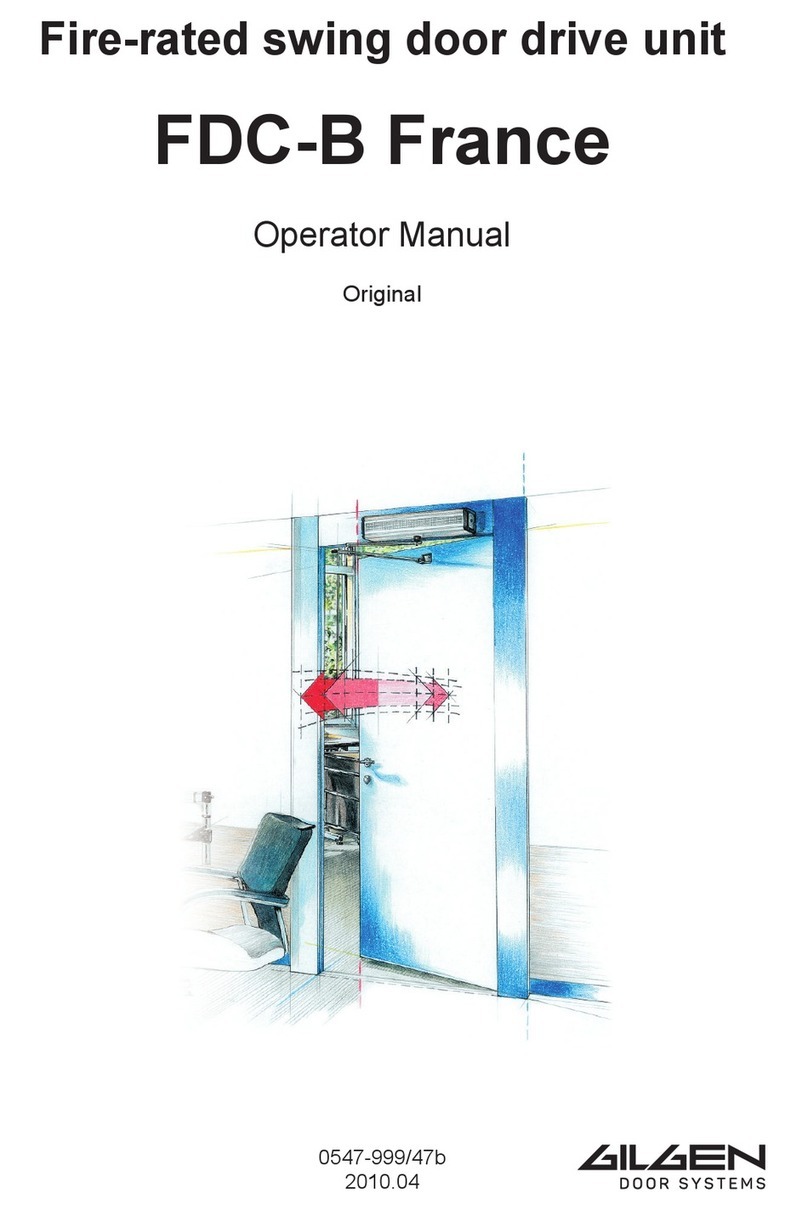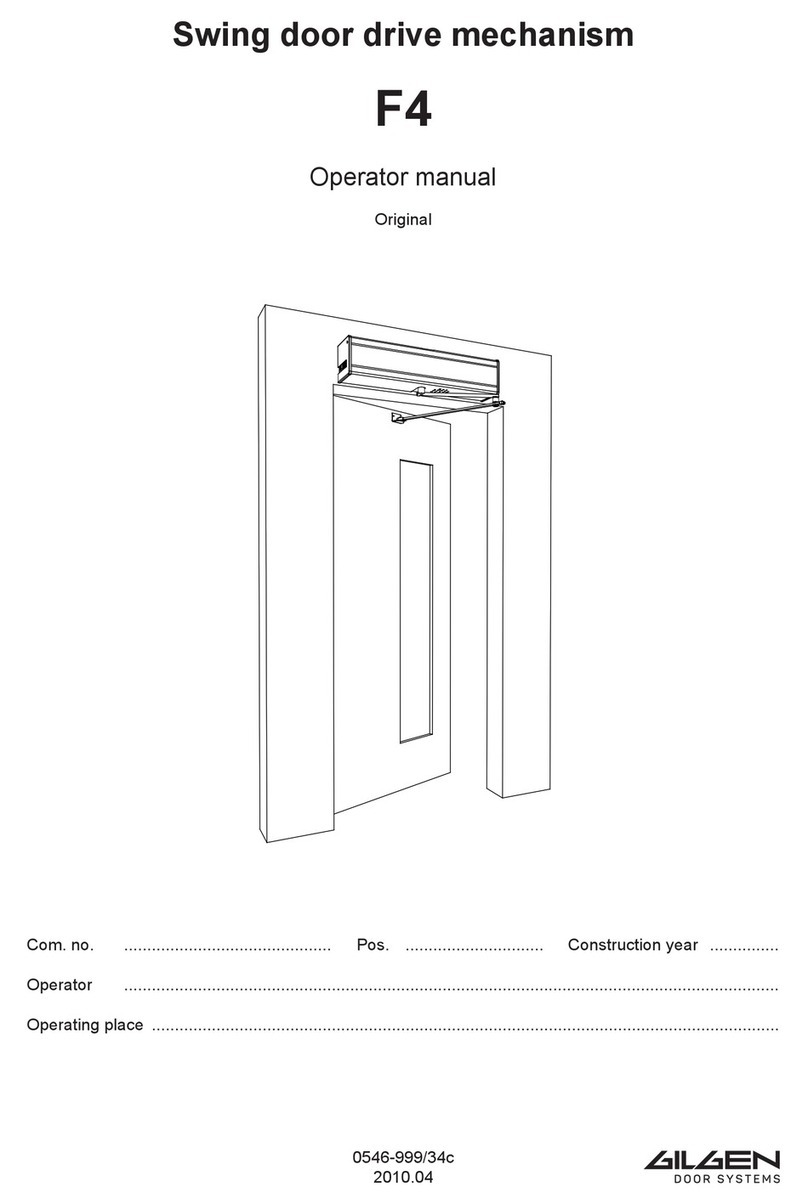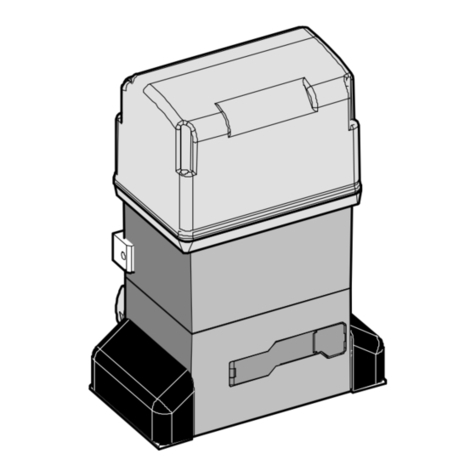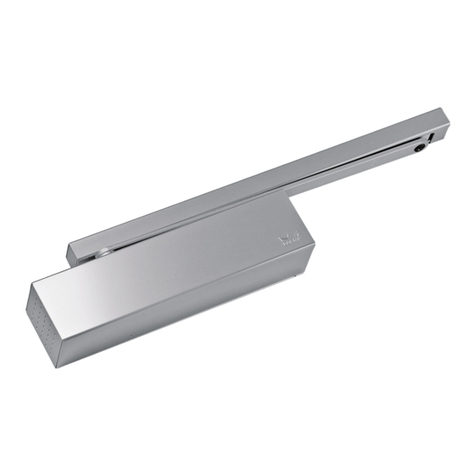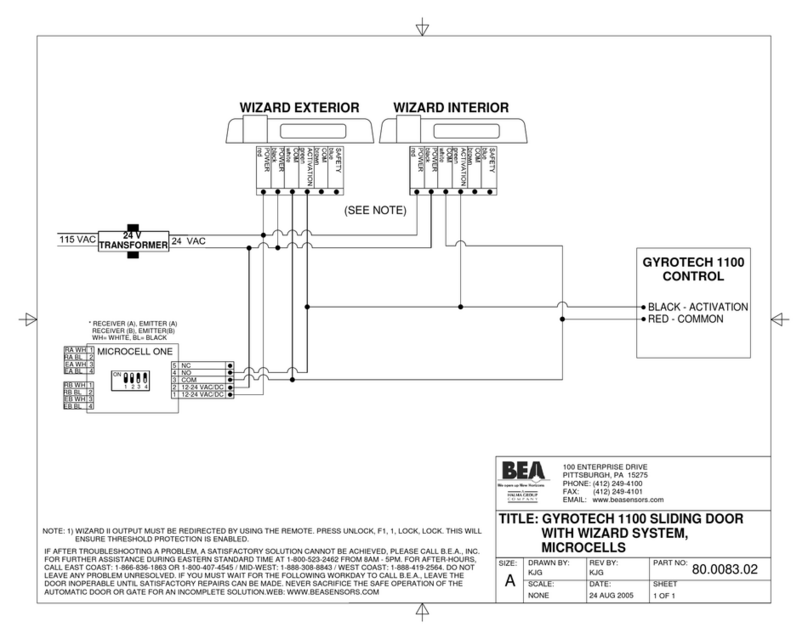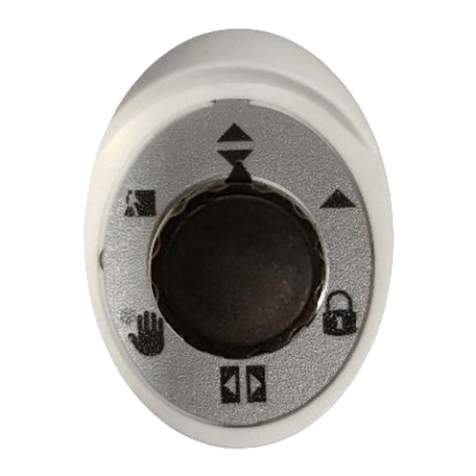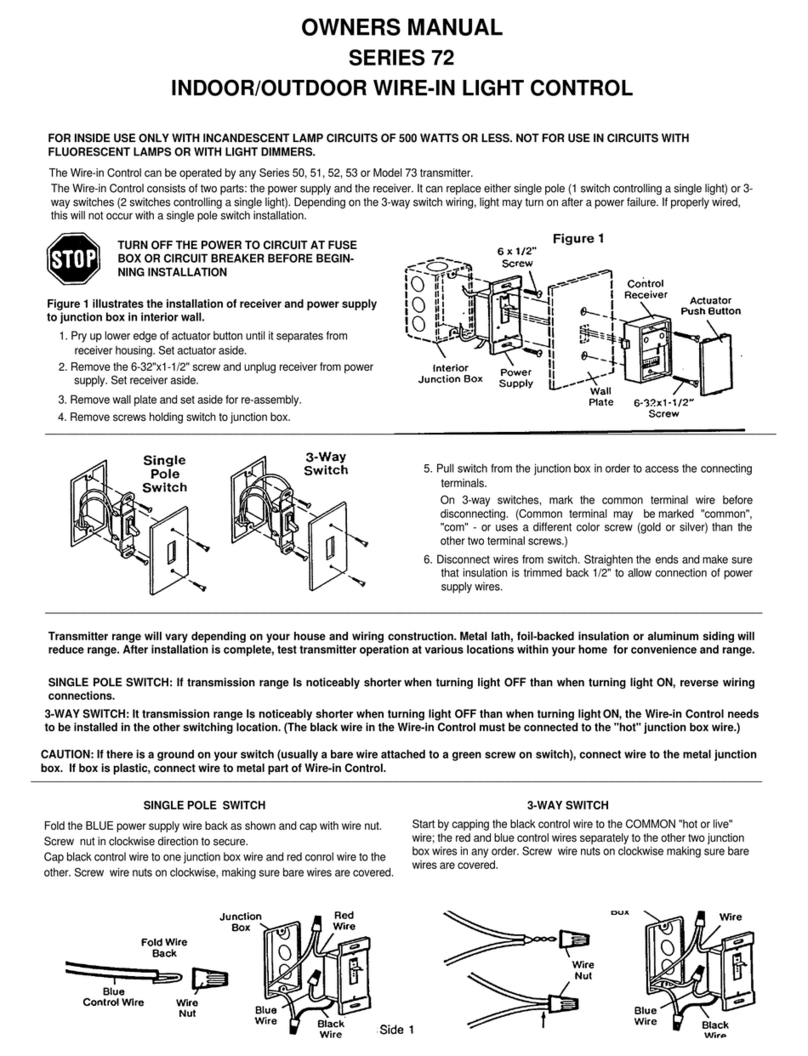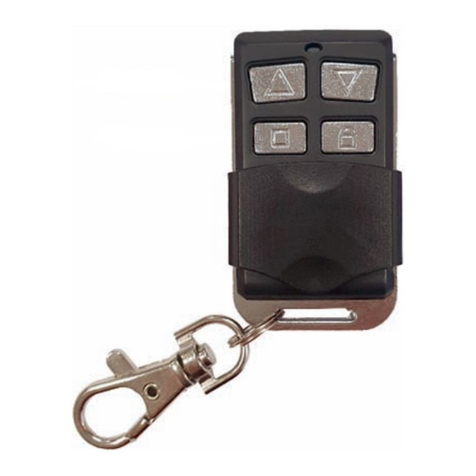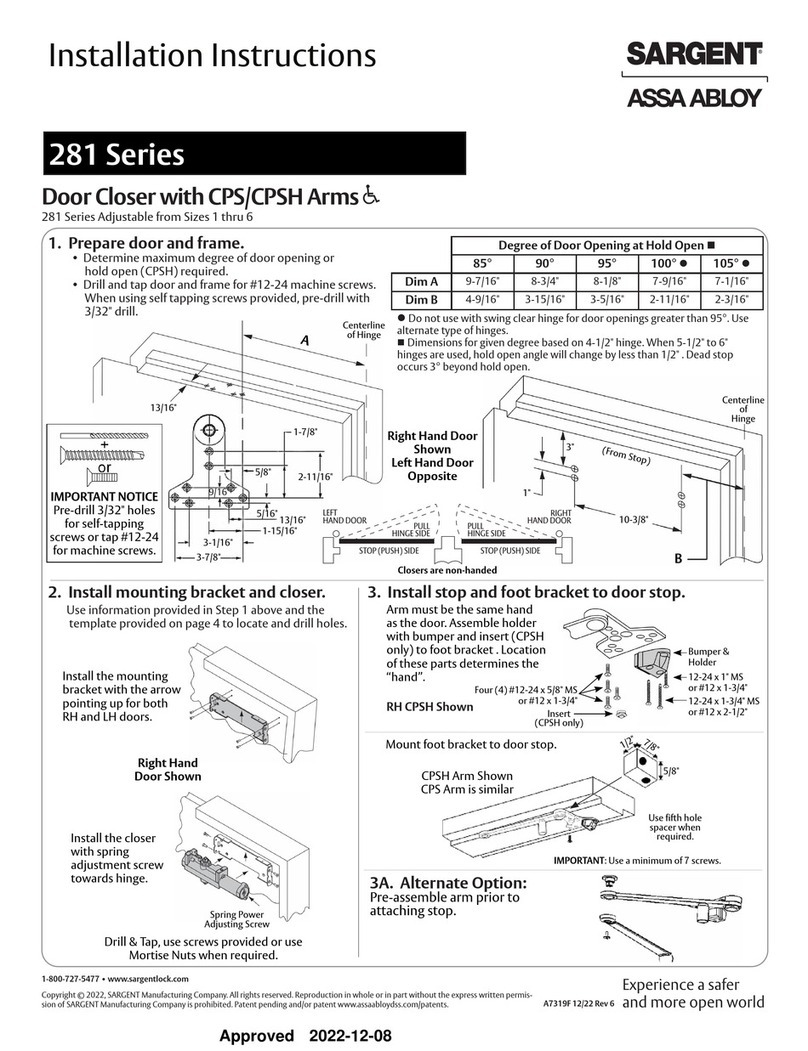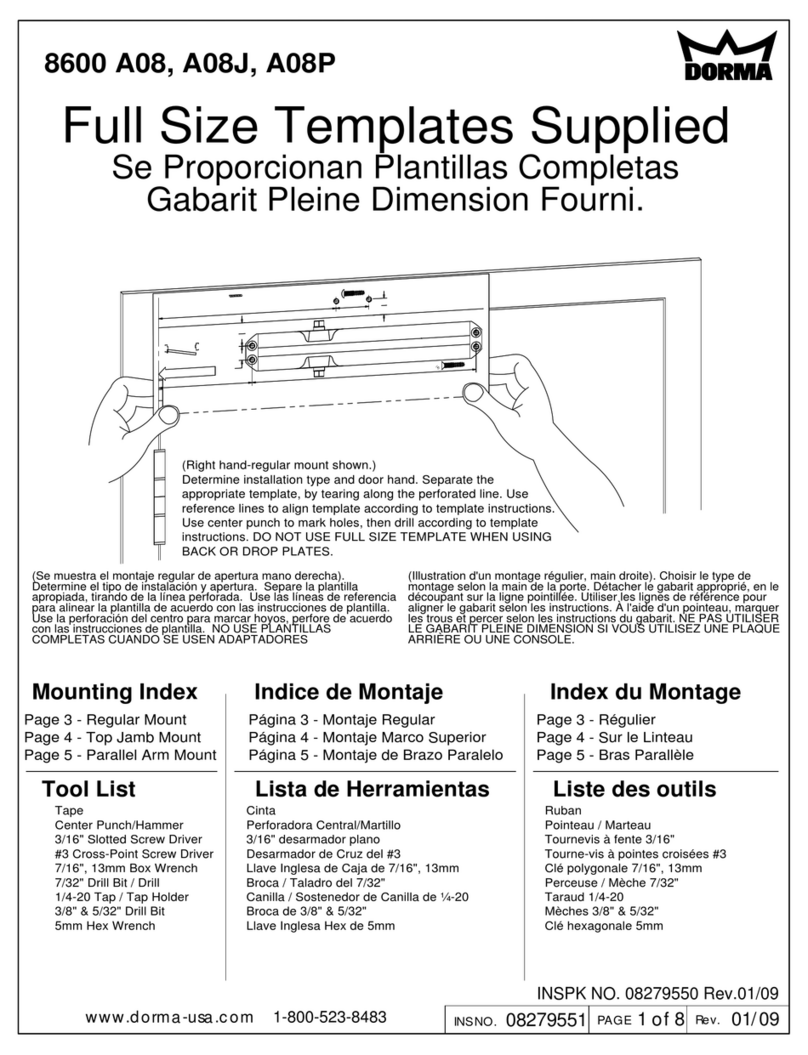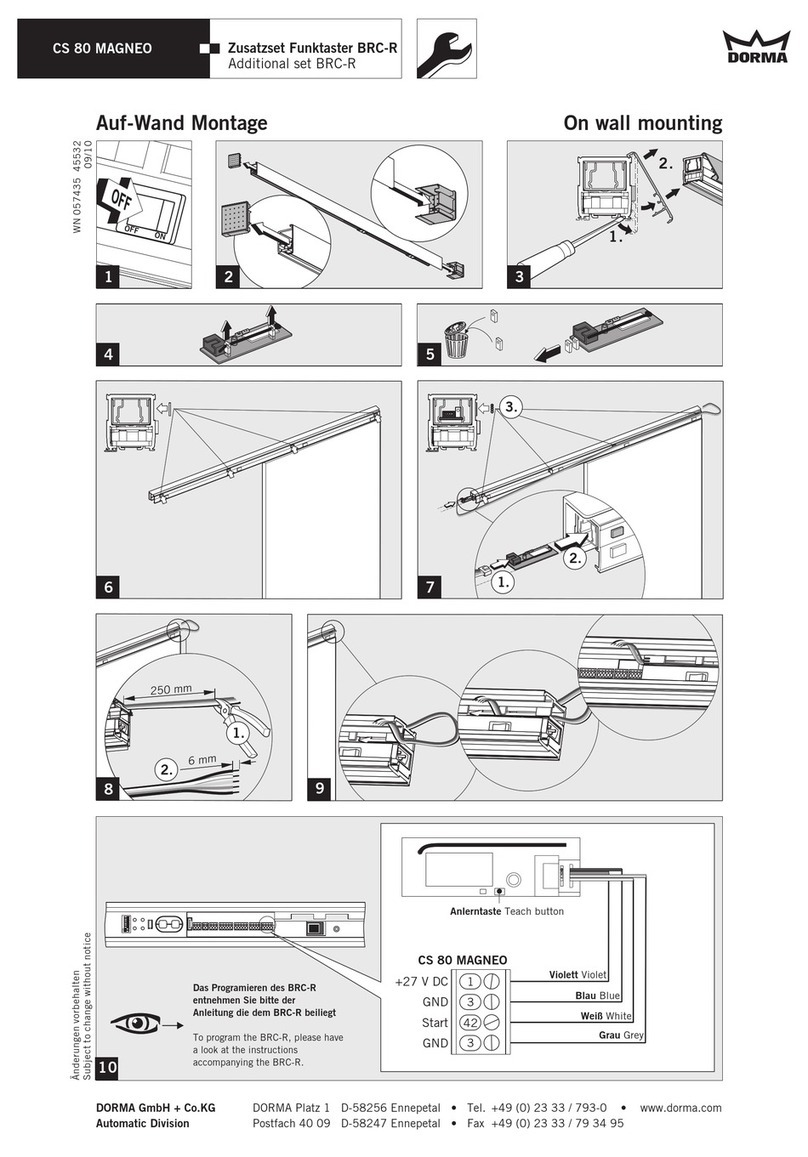GILGEN doorboy DBL-W User manual

0552-999/03
05.98
Kipptorantrieb für Wandmontage
doorboy DBL-W
Montage- und Betriebsanleitung

.

0552-999-03_05.98.p65 1-4
1
2
Fig. 1
190 -
240
3
451
Fig. 2
190 - 240
40
20
5
120±10
2
6
7
8
5
4
8
Fig. 3
85 85
8585
125
min. 860
200
Kipptorantrieb für Wandmontage doorboy
DBL-W
Montage und Inbetriebsetzung in Privatgarage
Der Gilgen Kipptorantrieb DBL-W wird für Seilzug-Kipptore verwen-
det, die sich durch Antrieb des Gegengewichtes in die jeweilige Auf-
und Zustellung bewegen lassen.
Für den elektrischen Anschluss muss bauseits eine Steckdose mit
10 A Absicherung vorgesehen werden.
Montagevorbereitungen
- Vorhandene Verriegelung des Tores ausser Funktion setzen.
- Schrauben und Muttern nachziehen.
- Wellen, Lager und Seil schmieren.
- Tor auf einwandfreien Lauf überprüfen. Das Tor muss sich leicht
von Hand, ohne zu klemmen, öffnen und schliessen lassen.
Gegebenenfalls Gewichtsausgleich korrigieren lassen.
- Falls vorhanden, bauseitige Toranschläge in der OFFEN-Stellung
einstellen.
- Verschalung des Gegengewichtes entfernen.
- Das Gegengewicht muss in Längs- und Querrichtung spielarm
geführt sein. Falls nötig Führungen ergänzen. Fig. 2
- Antrieb auspacken und Haube entfernen.
Montage des Antriebes
- Der Antrieb kann, je nach Platzverhältnissen, links oder rechts
vom Gegengewicht (1) montiert werden.
- Die Antriebsachse (2) in einer Distanz von 190 - 240 mm, parallel
zum Gegengewicht (1), vertikal auf der Mauer anzeichnen. Fig. 1
- Lage der Torkupplung (3) unter Einhaltung der Masse aus Fig. 2
und 3 auf dem Gegengewicht (1) anzeichnen.
- Anschweissplatte (4) auf Gegengewicht (1) anschweissen. Fig. 2
- Ausleger (5) auf Anschweissplatte (4) schrauben. Horizontale
Lage des Auslegers (5) für die Torstellungen OFFEN (6) und ZU
(7) auf die Wand übertragen. Fig. 3
- Kontrolle: Distanz zwischen Punkt (7) und Decke muss minde-
stens 860 mm betragen.
- 200 mm über Punkt (7) eine horizontale Linie ziehen. Von dieser
Linie aus obere und untere Befestigungslöcher (8) gemäss Fig. 3
anzeichnen.
Normtyp 1'550
Spezialtyp Hub + 350

0552-999-03_05.98.p65 2-4
25 26 28
27
34
35
Fig. 7b
5
19 14
15
16
18
17
Y
X
==
190 - 240
Fig. 6
115±10
20
40
X
10 10 ø10
9
12
Fig. 4
60
22
23
24
31
21
20
28
10
10
Fig. 5
211
Fig. 7a
z = 580
50
- Bei Punkt (8) mit Bohrer ø10; 60 mm tief bohren und Dübel (9)
ganz einschlagen. Fig. 3 und 4
- Die vier Winkel (10) sind beigepackt. Beidseitig Nutensteine in
Laufprofil einlegen und Winkel (10) mit den Rippenschrauben
festschrauben. Fig. 5
- Antrieb mit dem Antriebskopf (11) nach oben an die Wand
stellen. Antrieb anheben und Winkel (10) mit den beigepackten
Schrauben (12) gut in Dübel (9) befestigen. Fig. 4 und 5
- Antrieb muss so ausgerichtet sein, dass die Masse X und Y auf
ganzen Hub parallel verlaufen. Fig. 6
- Tor bis zum Anschlag öffnen. Mitnehmerwinkel (14) in Ausleger
(5) einführen. Am Schlitten (15) Bolzen (16) entfernen.
- Schlitten (15) am roten Knopf auskuppeln und auf die Höhe des
Mitnehmerwinkels (14) fahren. Schlitten (15) mit Bolzen (16)
durch das Gleitstück (17) ankuppeln, Bolzen (16) mit Federclips
(18) sichern. Fig. 6
- Mitnehmerwinkel (14) im Schlitten (15) einmitten und Schrauben
(19) festziehen.
Optionen und Zubehör
- Handentriegelung ENTRA-W für Garagen ohne zweiten Zugang.
- Bedienungselemente wie:
• Druckkontakt
• Schlüsselschwenkschalter
• Zusätzliche Handsender, Minisender u. a.
- Sicherheitselemente wie:
• Sicherheitsleiste EMS
• Servicetürkontakt u. a.
Montage der Optionen
Handentriegelung ENTRA-W, Fig. 7a + 7b
Vorbereitung: - Spannschraube (20) auf ENTRA-W ganz ein-
schrauben.
- Druckfeder (21) einfahren, Seilende (22) einfah-
ren und mit Schraubnippel (23) befestigen.
Montage: - ENTRA-W mit Schraube (24) auf Anschlag (31)
schrauben.
- Seil und Bowdenzughülle (28) mit grossen Radien
und genug Bewegungsfreiheit zum Torschloss
führen.
- Winkel (25) mit Schrauben (26) und Spannschrau-
be (27) auf Tor montieren.
- Schraube (34) am Torschloss ersetzen.
- Zweites Seilende durch Spannschraube (27) und
Schlossschraube (34) führen und mit Schraubnip-
pel (35) befestigen.
- Spannschraube (20) und (27) anziehen und mit
Kontermutter arretieren.
Kontrolle: - Beim Betätigen des Torschlosses muss der Antrieb
auskuppeln.
- Das Tor lässt sich öffnen.

0552-999-03_05.98.p65 3-4
29
30
15
Fig. 8
20
15
31
32
34
Fig. 9
15
Elektrische Anschlüsse
Achtung:
Bei allen Arbeiten am Antrieb Netzstecker ausziehen!
- Alle im Antrieb montierten elektrischen Elemente sind ange-
schlossen.
- Die Kabel der externen Bedienungs- und Sicherheitselemente
werden von oben (hinter der Netzsteckdose) in den Antrieb
eingeführt.
- Kabel ausserhalb des Antriebes mit geeignetem Mittel fixieren.
Achtung:
Bauseits anzubringende Bedienungselemente dürfen
nicht im Schwenkbereich des Tores installiert werden!
- Alle Anschlüsse auf die Steuerung erfolgen nach dem Schema
0141-199 in der Antriebshaube.
- Kontrollen: • Wird keine Lichtschranke auf Stecker X3, Klem-
men 4 - 8 angeschlossen, muss eine Brücke von
Klemme 5 auf Klemme 7 eingelegt sein.
• Auf Stecker X3, Klemmen 9 - 10 und 9 - 11
muss entweder eine Brücke eingelegt sein, oder
das Kabel der Sicherheitselemente angeschlos-
sen sein.
• Die Funkfernsteuerung F7000 muss mit einem
persönlichen Code versehen werden. Sender
und Empfänger müssen die gleiche Codierung
aufweisen. Die Montage erfolgt nach den
jeweils beigelegten Anleitungen.
Inbetriebnahme
- Kontrollen: • Tor am Schlitten (15) durch Ziehen des roten
Knopfes auskuppeln. Tor von Hand öffnen
und wieder schliessen. Es muss leicht und hin-
dernisfrei laufen.
• Der Mitnehmerwinkel (14) darf in der Horizon-
talen keine Kräfte auf den Schlitten (15) über-
tragen.
• Sind alle elektrischen Anschlüsse korrekt?
• Sind die DIL-Schalter entsprechend der gewün-
schten Funktion eingestellt? (siehe Schema in
der Haube).
Standardfunktion:
Schrittschaltung AUF-HALT-ZU (SS AHZ)
S 1.1 ON
S 1.2 OFF
S 1.3 ON
S 1.4 OFF
S 1.6 OFF (Lichtzeit)
- Haube montieren und Netzstecker einstecken.
- Bei der ersten Inbetriebnahme mit einer Tormasse richtet sich der
Antrieb selber ein. Fahrweg, Tormasse und die Reibung werden
gemessen und gespeichert.
Achtung: Das Tor darf beim Einrichtvorgang nicht behindert
werden.
- Als erste Bewegung will der Antrieb eine langsame Schliessung
durchführen.
- Einen Impuls (Funk oder Drucktaster) geben, der Antrieb öffnet
mit langsamer Geschwindigkeit.
- Kontrolle, ob das ganz geöffnete Tor beidseitig an den Toran-
schlägen ansteht, (falls vorhanden).
- Offenanschlag (29) im Antrieb einstellen. Schrauben (30) leicht
lösen, Anschlag schieben bis er am Schlitten (15) ansteht.
Anschlag ca. 20 mm zurückschieben und Schrauben (30) fest-
ziehen. Fig. 8
- Impuls geben, das Tor schliesst.
- Zuanschlag (31) im Antrieb einstellen. Schrauben (32) leicht
lösen, Anschlag schieben bis er am Schlitten (15) ansteht (Mass
15 mm). Schrauben (32) festziehen. Fig. 9
- Impuls geben, das Tor schliesst mit normaler Geschwindigkeit.
Mit einem weiteren Impuls öffnet das Tor mit normaler Geschwin-
digkeit.
- Die Lichtzeit ist auf ca. 180 Sek. eingestellt. Sie kann am Poten-
tiometer R49 verändert werden, wenn der DIL-Schalter S 1.6 auf
OFF steht. (siehe Schema in der Haube)
- Weitere Einstellungen können mit Hilfe des Bediengerätes BEDIS
(Option) vorgenommen werden.
- Falls sich nach mehreren Torbewegungen das Seil bereits ge-
streckt hat, den Zuanschlag (31) noch einmal nachstellen, damit
er in ZU-Stellung am Schlitten (15) anliegt.
- Falls der Einrichtvorgang nicht korrekt abgelaufen ist oder eine
Störung aufgetreten ist, kann dieser wiederholt werden, indem
die Reset-Taste (34) (blauer Knopf) bei eingeschaltetem Netz
während min. 2 Sek. gedrückt wird. Fig. 9

0552-999-03_05.98.p65 4-4
33
90°
max. 150 N
Fig. 10
Kontrolle der Schliesskraft
Nach der EKAS-Richtlinie 1511 muss die Kraft an der Schliesskante
des Tores auf 150 N begrenzt werden.
- Tor über Impulsgeber schliessen und während des Schliessvor-
gangs manuell anhalten. Bei einer aufzuwendenden Kraft von
max. 150 N muss der Antrieb wieder öffnen. Schematische
Anordnung zur Messung dieser Kraft mittels Federwaage (33)
gemäss Fig. 10.
- Sollte die erforderliche Anhaltekraft 150 N überschreiten, muss
eine Nachjustierung mit Hilfe des BEDIS erfolgen.
Zustandsanzeigen auf der DBL-Steuerung
Auf der Steuerung LED D31 bis D34
• D31 (grün) Öffnungs- oder Schliessbefehl steht an.
• D32 (grün) Halt-Befehl steht an.
• D33 (grün) Reversierbefehl steht an.
• D34 (rot) Systemfehler. Eine detailierte Fehleranalyse kann
durch Fachpersonal mit dem BEDIS vorgenommen
werden.
Funktions- und Bedienungsanleitung
Der Gilgen-Kipptorantrieb kann durch Impulsgeber wie Funkfern-
steuerung, Schlüsselschalter, externe Drucktaster betätigt werden. Es
ist nur eine kurze Impulsgabe erforderlich.
Schrittschaltfunktion AUF-HALT-ZU:
Tor ist geschlossen:
Einmalige Impulsgabe öffnet das Tor.
Tor ist geöffnet:
Einmalige Impulsgabe schliesst das Tor.
Tor in Bewegung:
Einmalige Impulsgabe stoppt das Tor.
Erneuter Impuls bewirkt ein Anlaufen des Tores in die entgegenge-
setzte Richtung.
Sicherheitsautomatik:
Im Schwenkbereich des Tores dürfen sich keine Personen oder Ge-
genstände befinden. Sollte dies durch Unachtsamkeit doch einmal der
Fall sein, bewirkt die Steuerung des Antriebes beim Auflaufen auf ein
Hindernis während des Schliessvorganges ein Reversieren (Um-
schaltbar mit dem BEDIS auf Halt mit Selbstbefreiung). Läuft das Tor
beim Öffnungsvorgang auf ein Hindernis, stoppt der Antrieb sofort und
läuft etwas zu. Beim nächsten Impuls schliesst das Tor wieder.
Bei Überwachung des Torschwenkbereiches durch externe Sicher-
heitselemente (z. B. Lichtschranke, Kontaktleiste) reversiert ein sich
schliessendes Tor sofort wenn sich eine Person oder ein Gegenstand
im Überwachungsbereich des Sicherheitselementes befindet.
Notentriegelung:
Bei Stromausfall oder sonstigen Störungen kann das Tor durch Dre-
hen des Torgriffes von aussen oder durch Ziehen des roten Knopfes
von innen, entriegelt werden. Der Laufschlitten wird dabei von der
Antriebskette getrennt. Das Tor ist leicht von Hand zu öffnen. Ist die
Störung beseitigt oder der Strom wieder eingeschaltet, läuft die Kette
nach Impulsgabe automatisch in den Laufschlitten ein und das Tor
wird geöffnet.
Beleuchtung:
Werkseitig ist der Antrieb mit einer Fassung E14-230 V und Kerzen-
glühlampe 25 W ausgerüstet.
Die Beleuchtung schaltet sich beim Öffnungsimpuls ein und nach ca.
180 Sek. wieder aus.
Änderungen vorbehalten
Masse in mm
Anhang
Schema .............................................................................. E4-0141-199
Tor schliesst/öffnet nicht vollständig. *
Antrieb lässt sich durch Sendeimpuls nicht aktivieren, kann jedoch
durch Drucktaster oder andere Impulsgeber betätigt werden.
Antrieb lässt sich weder durch Sendeimpuls noch durch andere
Bedienungselemente aktivieren.
Geringe Reichweite der Fernsteuerung.
* Diese Störung kann möglicherweise durch drücken der Reset-Taste behoben werden.
- Leere Batterie auswechseln.
- Standort-Korrektur des Empfängers vornehmen.
- Leere Batterie auswechseln.
- Kabelanschlüsse und Steckverbindungen des Empfängers kon-
trollieren.
- Codierung des Senders und Empfängers gemäss F7000-Anlei-
tung angleichen.
- Prüfen, ob Spannung 230 V an Steckdose anliegt.
- Eventuell Hauptsicherung wieder einschalten.
- Bei losen Kabelanschlüssen bzw. defekten Gerätesicherungen
Netzstecker ziehen und Anschlüsse wieder herstellen, defekte
Gerätesicherungen 2 AT auswechseln.
- Mit BEDIS Motorstromgrenzen neu justieren.
- Tor auskuppeln und Leichtgängigkeit prüfen.
- Läuft Antrieb mit ausgekuppeltem Tor den ganzen Fahrweg?
Tor steuert nicht um, wenn es während des Schliessvorganges auf
Widerstand läuft.
Tor bleibt nicht stehen (Motor schaltet nicht ab), wenn es während
der Öffnungsbewegung auf Widerstand stösst.
Abhilfe (nur durch Sachkundige)Störung
Fehlersuchanleitung


.

0552-999/03
05.98
Drive unit for single-leaf overhead
door for mounting against the wall
doorboy DBL-W
Assembly- and operating instructions

.

0552-999-03_05.98.p65 1-4
1
2
Fig. 1
190 -
240
3
451
Fig. 2
190 - 240
40
20
5
120±10
2
6
7
8
5
4
8
Fig. 3
85 85
8585
125
min. 860
200
Doorboy DBL-W drive unit for single-leaf
overhead door for mounting against the wall
Installation and commissioning in private garage
The Gilgen DBL-W drive unit is used for single-leaf overhead doors with
cable system whose open and closed position can be reached by driving
the counter-weight. For the electric power supply, a plug socket with 10 A
fuse must be provided by customers.
Assembly preparations
- Disconnect any existing locking of the door.
- Tighten the screws and nuts.
- Grease the shafts, the bearings and the cable.
- Check the free running movement of the door. It must be easily
possible to open and close the door by hand (no jamming of the
door). If necessary, have the weight compensation unit
readjusted.
- Adjust any existing customer-supplied door stop pieces in the
OPEN position.
- Remove the covering of the counter-weight.
- The counter-weight must be guided with a minimal play in the
longitudinal and in the transversal sense. If necessary complete
the guideways. Fig. 2
- Unwrap the drive unit and remove the cover.
Mounting the drive unit
- Depending on the available space, the drive unit can either be-
mounted on the right or on the left side of the counter-weight (1).
- At a distance of 190 to 240 mm, mark the drive axis (2) vertically
on the wall, in parallel to the counter-weight (1). Fig. 1
- Mark the position of the door coupling (3) on the counter-weight
(1), observing the measures according to Fig. 2 and 3.
- Weld the welding plate (4) onto the counter-weight (1). Fig. 2
- Screw the extension arm (5) into the welding plate (4). Transfer
the horizontal position of the extension arm (5) for the OPEN (6)
and CLOSED (7) position of the door on the wall. Fig. 3
- Checking: The distance between point (7) and the ceiling must
be at least 860 mm.
- 200 mm above point (7), draw a horizontal line. Starting from this line,
mark the upper and lower fixing holes (8) according to Fig. 3.
Normtype 1'550
Specialtype stroke + 350

0552-999-03_05.98.p65 2-4
25 26 28
27
34
35
Fig. 7b
5
19 14
15
16
18
17
Y
X
==
190 - 240
Fig. 6
115±10
20
40
X
10 10 ø10
9
12
Fig. 4
60
22
23
24
31
21
20
28
10
10
Fig. 5
211
Fig. 7a
z = 580
50
- At point (8), drill a hole 60 mm deep, using a drill ø10 and drive
the dowels (9) completely home. Fig. 3 and 4
- The four angles (10) are included in the delivery. Insert the tenon
blocks on both sides into the running profile and screw down the
angle (10) by means of the countersunk bolts with double nip.
Fig. 5
- Place the drive unit against the wall, with the drive head (11)
pointing upward. Lift the drive unit and securely fasten the ang-
les (10) into the dowels (9) by means of the screws (12) which are
supplied together with the drive unit. Fig. 4 and 5
- The drive unit must be adjusted in such a manner that the mea-
sures X and Y are parallel on the entire door stroke. Fig. 6
- Open the door as far as the door stop piece. Insert the driver angle
(14) into the extension arm (5). Remove the bolt (16) on the sliding
carriage (15).
- Uncouple the sliding carriage (15) by means of the red button and
move it up to the height of the driver angle (14). Couple the sliding
carriage (15) with the bolt (16) by means of the glider (17), and se-
cure the bolt (16) by means of the spring clips (18). Fig. 6
- Center the driver angle (14) in the sliding carriage (15) and tighten
the screws (19).
Options and fittings
- Manual unlocking mechanism ENTRA-W for garages without a se-
cond access.
- Control elements such as:
• Push-button
• Key-operated switch
• Additional hand-held transmitters, mini-transmitters, etc.
- Safety elements such as:
• Safety edgings EMS
• Service door contact, and others
Mounting the options
Manual unlocking mechanism ENTRA-W, Fig. 7a + 7b
Preparation: - Completely tighten the tension screw (20) on
ENTRA-W.
- insert the pressure spring (21). Insert the cable end
(22) and fasten it by means of the screw nipple (23)
Assembly: - Screw ENTRA-W onto the stop piece (31) with screw
(24).
- Lead the cable and the Bowden cable covering (28)
up to the door lock, describing large radii and ma-
king sure the door has a sufficiently free running
movement.
- Mount the angle (25) on the door by means of
screws (26) and tension screw (27).
- Replace screw (34) on the door lock.
- Pull the second cable end through the tension
screw (27) and the screw of the lock (34) and fix it
by means of the screw nipple (35).
- Tighten the tension screws (20) and (27) and secure
them with a counter-nut.
Checking: - When the door lock is actuated, the drive unit must
be uncoupled
- The door can be opened.

0552-999-03_05.98.p65 3-4
29
30
15
Fig. 8
20
15
31
32
34
Fig. 9
15
Electrical connections
Warning:
Always pull out the power plug before working on
the drive unit!
- All the electrical elements mounted within the drive unit are con-
nected.
- The cables of the external operating and safety elements are intro-
duced into the drive unit from above (behind mains plug socket).
- The cables outside of the drive unit have to be fastened by the
appropriate means.
Warning:
Any operating elements to be installed by customers
must not be mounted within the pivoting
range of the door!
- All the connections on the control unit are made according to dia-
gram 0141-199 in the drive unit cover.
- Checking: • If no photoelectric cell is connected on plug X3,
terminals 4 - 8 , a bridge connection must be
made between terminal 5 and terminal 7.
• On plug X3, terminals 9 - 10 and 9 - 11, either
a bridge connection must be made or the cable
of the safety elements must be connected.
• The remote radio control F7000 must be pro-
grammed with a personal code. This code must
be the same for the transmitter and the receiver.
Assembly according to the enclosed respective
instructions.
Commissioning
- Checking • Uncouple the door on the sliding carriage (15) by
pulling the red knob. Manually open and close
the door. It should move easily and without
hindrance.
• In the horizontal line, the driver angle (14) must
not transmit any forces onto the sliding carriage
(15).
• Are all the electrical connections OK?
• Have the DIL switches been adjusted according
to the required function? (See diagram in the
cover).
Standard function:
Step-by-step func. OPEN-STOP-CLOSE (SS AHZ)
S 1.1 ON
S 1.2 OFF
S 1.3 ON
S 1.4 OFF
S 1.5 OFF (illumination time)
- Mount the cover and plug in the power plug.
- When the drive unit is taken into operation for the first time with
a door mass, the setting-up procedure is automatically carried
out. The travel distance, the door mass and the friction are mea-
sured and memorized.
Attention: During the setting-up procedure, the door must not
be hindered.
- The first movement that the drive unit wants to carry out is a slow
closing procedure.
- Give an impulse (by radio control or push-button); the drive unit
opens at slow speed.
- Check whether the completely opened door touches the door
stops on both sides (if there are any).
- Adjust the stop piece for the open position (29) in the drive unit.
Slightly loosen the screws (30) and push the stop piece until it
meets the sliding carriage (15). Then retract the stop piece by
approx. 20 mm and tighten the screws (30). Fig. 8
- Give an impulse; the door closes.
- Adjust the stop piece for the closed position (31) in the drive unit.
Slightly unscrew the screws (32), push the stop piece until it tou-
ches the sliding carriage (15) (measure 15 mm). Tighten the
screws (32). Fig. 9
- Give an impulse; the door closes at normal speed. A further
impulse causes the door to open at normal speed.
- The illumination time has been adjusted for approx. 180 sec. It
can be changed at the potentiometer R49, provided that the DIL
switch S 1.6 is positioned on OFF (see diagram in the cover).
- Further adjustments can be made by means of the control device
BEDIS (option).
- Should the cable already have been lengthened after several
door movements, the position of the stop piece for the closed
position (31) must be corrected so that it touches the sliding
carriage (15) in the CLOSED position.
- If the setting-up procedure has not been carried out correctly, it
can be repeated by pressing the reset key (34) (blue button)
during at least 2 sec. with the mains supply switched on. Fig. 9

0552-999-03_05.98.p65 4-4
33
90°
max. 150 N
Fig. 10
Modification reserved
Dimensions in mm
Checking the closing force
According to the FCOS-regulations 1511, the force on the closing
edge of the door must be limited to 150 N.
- Close the door via an impulse transmitter and manually stop it
during the closing procedure. With an applied force of max.
150 N, the drive unit shall reopen. Diagrammic arrangement for
measuring this force by means of a spring balance (33) according
to Fig. 10.
- Should the required stopping force exceed 150 N, a readjustment
must be made by means of the BEDIS.
Status displays on the control unit
On the control LED D31 to D34
• D31 (green) An opening or closing command is pending.
• D32 (green) A stopping command is pending.
• D33 (green) A reversing command is pending.
• D34 (red) System error. The specialists can carry out a
detailed error analysis by means of the BEDIS.
Functional and operating instructions
The Gilgen drive unit for overhead doors can be operated by impulse
transmitters such as remote radio control, key-operated switch or
external push-buttons. Only a short impulse is required.
Step-by-step function OPEN-STOP-CLOSE:
The door is closed:
A single impulse opens the door.
The door is open:
A single impulse closes the door.
The door is in motion:
A single impulse stops the door.
A further impulse causes the door to reverse its movement.
Safety mechanism:
Neither persons nor objects are supposed to stay within the pivoting
range of the door leaf. Should this rule inadvertently not be followed,
the control of the drive unit is designed for the following safety
function: As soon as the door leaf meets an obstacle during the
closing procedure, its movement is reversed (this function can be
changed to STOP with autorelease by means of the BEDIS). Should
the door encounter an obstacle during the opening procedure, the
drive unit automatically stops and the door is shortly reversed. The
next impulse causes the door to close.
If the pivoting range of the door is monitored by external safety ele-
ments (such as photoelectric cells, contact sills etc.), a closing door is
immediately reversed as soon as the presence of a person or an
object is detected within the monitoring range of the safety element.
Emergency unlocking:
In the event of a power failure or other malfunctions, the door can be
unlocked from the outside by turning the door handle or from the
inside by pulling the red knob. This causes the sliding carriage to be
separated from the drive chain. Now the door can be easily opened by
hand. As soon as the cause of the malfunction has been eliminated or
the power supply been restored, the chain automati-cally enters the
sliding carriage when an impulse is given and the door is opened.
Illumination:
The drive unit is supplied with a built-in socket E14-230 V and an
incandescent candle lamp 25 W.
The illumination is switched on when the opening impulse is given and
switched off after approx. 180 sec.
Appendix
Diagram ............................................................................. E4-0141-199
Malfunction Troubleshooting (only by qualified staff)
Door fails to close/open completely. * - Uncouple the door and check the free running movement.
- When the door is uncoupled, does the drive unit carry out the
complete door stroke?
- Readjust the motor current limits by means of the BEDIS.Door movement is not reversed when it meets an obstacle during the
closing procedure.
Door is not stopped (motor is not switched off) if it meets an obstacle
during the opening procedure.
The drive unit cannot be activated by a transmit impulse, but it can
be actuated by means of a push-button or other pulse generators.
- Replace the empty battery.
- Check the cable connections and the plug-in connections of the
receiver.
- Adapt the coding of the transmitter and the receiver according to
the F7000 instructions.
- Check if there is a voltage of 230 V at the plug socket.
- If necessary switch the main fuse on again.
- In the event of loose cable connections resp. defective miniature
fuses: pull out the power plug and restore the connections,
replace any defective miniature fuses 2 AT.
- Replace the the empty battery.
- Proceed to a correction of the receiver's location.
Insufficient range of the remote control.
Drive unit can be actuated neither by a transmitter impulse nor by
any other control elements.
Troubleshooting instructions
* This malfunction can possibly be eliminated by pressing the RESET key.


.

0552-999/03
05.98
Mécanisme d'entraînement pour porte
basculante, pour montage contre la
paroi
doorboy DBL-W
Instructions de montage et d'exploitation

.

0552-999-03_05.98.p65 1-4
1
2
Fig. 1
190 -
240
3
451
Fig. 2
190 - 240
40
20
5
120±10
2
6
7
8
5
4
8
Fig. 3
85 85
8585
125
min. 860
200
Mécanisme d'entraînement doorboy DBL-W
pour porte basculante, pour montage contre
la paroi
Montage et mise en marche dans un garage privé
Le mécanisme d'entraînement Gilgen DBL-W est utilisé pour des portes
basculantes avec système à câble qui peuvent être ouvertes
respectivement fermées par l'entraînement du contre-poids. Pour le
raccordement électrique, une prise de courant avec fusible 10 A doit être
prévue par le commettant.
Préparation du montage
- Mettre hors fonction le verrouillage existant de la porte.
- Resserrer les vis et les écrous.
- Graisser les arbres, les paliers et le câble.
- Contrôler le libre mouvement de la porte. Il doit être facilement
possible d'ouvrir et de fermer la porte à la main sans qu'elle
coince. Si nécessaire, faire corriger la compensation du poids
- Régler les butées existantes de la porte dans la position OUVERT,
le cas échéant.
- Démonter le revêtement du contre-poids.
- Le contre-poids doit être guidé avec un minimum de jeu dans les
sens longitudinal et transversal. Si nécessaire compléter les guida-
ges. Fig. 2
- Déballer le mécanisme d'entraînement et enlever le capot.
Montage du mécanisme d'entraînement
- Suivant l'espace disponible, l'entraînement peut être monté soit à
gauche soit à droite du contrepoids (1).
- A une distance de 190 à 240 mm, marquer l'axe d'entraînement
(2) parallèlement au contre-poids (1), verticalement sur le mur.
Fig. 1
- Marquer la position de l'accouplement de la porte (3) sur le contre-
poids (1), en respectant les cotes selon Fig. 2 et 3.
- Souder la plaque à souder (4) sur le contre-poids (1). Fig. 2
- Visser l'avant-bras (5) contre la plaque à souder (4). Reporter la
position horizontale de l'avant-bras (5) pour les positions OUVERT
(6) et FERME (7) de la porte sur la paroi. Fig. 3
- Contrôle: La distance entre le point (7) et le plafond doit être de
860 mm au minimum.
- 200 mm au-dessus du point (7), tracer une ligne horizontale.
A partir de cette ligne, marquer les trous de fixation supérieurs et
inférieurs (8) selon Fig. 3.
Type normalisé 1'550
Type spécial course + 350

0552-999-03_05.98.p65 2-4
25 26 28
27
34
35
Fig. 7b
5
19 14
15
16
18
17
Y
X
==
190 - 240
Fig. 6
115±10
20
40
X
10 10 ø10
9
12
Fig. 4
60
22
23
24
31
21
20
28
10
10
Fig. 5
211
Fig. 7a
z = 580
50
- Au point (8), percer un trou d'une profondeur de 60 mm en utili-
sant un foret ø10 et enfoncer complètement les chevilles (9).
Fig. 3 et 4
- Les quatres équerres (10) font partie de la livraison. Insérer les
coulisseaux aux deux côtés du profil de roulement et fixer l'équerre
(10) avec les boulons à tête conique à deux ergots. Fig. 5
- Placer l'entraînement contre la paroi, la tête de l'entraînement (11)
étant dirigée vers le haut. Lever l'entraînement et bien fixer
l'équerre (10) dans les chevilles (9) au moyen des vis (12) fournies
avec l'entraînement. Fig. 4 et 5
- L'entraînement doit être ajusté de manière à ce que les cotes X et Y
soient parallèles sur toute la course. Fig. 6
- Ouvrir la porte jusqu'à la butée d'arrêt. Insérer l'équerre entraî-
neuse (14) dans l'avant-bras (5). Enlever le boulon (16) du coulis-
seau (15).
- Découpler le coulisseau (15) moyennant le bouton rouge et le dé-
placer jusqu'à la hauteur de l'équerre entraîneuse (14). Accoupler
le coulisseau (15) avec le boulon (16) moyennant la pièce coulis-
sante (17), bloquer le boulon (16) par des clips de fixation (18).
Fig. 6
- Centrer l'équerre entraîneuse (14) dans le coulisseau (15) et serrer
les vis (19).
Options et accessoires
- Déverrouillage manuel ENTRA-W pour garages sans deuxième
accès.
- Eléments de commande tels que:
• Bouton-poussoir
• Interrupteur à clé
• Emetteursde poche complémentaires, mini-émetteurs, etc.
- Eléments de sécurité tels que:
• Liste de sécurité EMS
• Contact de porte de service, et autres
Montage des options
Déverrouillage manuel ENTRA-W, Fig. 7a + 7b
Préparation: - Complètement serrer la vis de tension (20) sur
ENTRA-W.
- introduire le ressort de pression (21). Insérer
l'extrémité du câble (22) et la fixer moyennant le
raccord fileté (23).
Montage: - Visser l'ENTRA-W contre la butée d'arrêt (31) avec
la vis (24).
- Conduire le câble et la gaine du câble Bowden (28)
jusqu'à la serrure de porte, en assurant de grands
rayons et suffisamment de liberté de mouvement.
- Monter l'équerre (25) sur la porte au moyen des vis
(26) et de la vis de tension (27).
- Remplacer la vis (34) à la serrure de porte.
- Tirer la deuxième extrémité du câble à travers la vis
de tension (27) et la vis de la serrure (34) et fixer
avec le raccord fileté (35).
- Serrer les vis de tension (20) et (27) et bloquer par
un contre-écrou.
Contrôle: - Lorsque la serrure de porte est actionnée, l'entraî-
nement doit être débrayé.
- La porte peut être ouverte.
Table of contents
Languages:
Other GILGEN Door Opening System manuals




